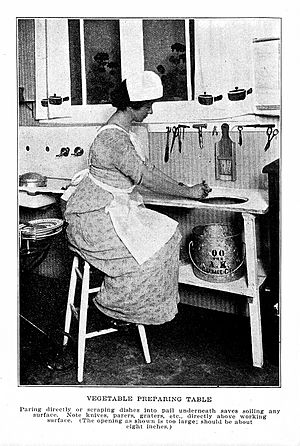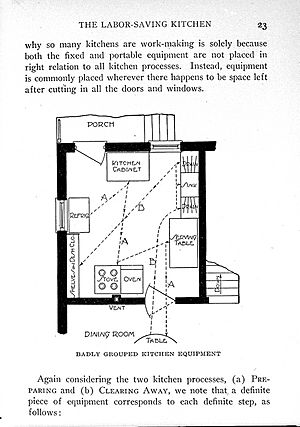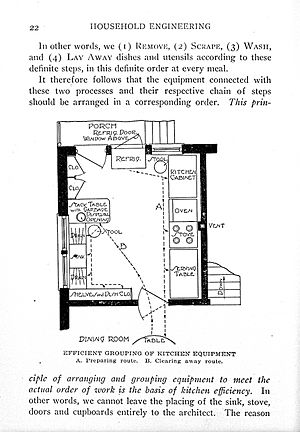Christine Frederick facts for kids
Quick facts for kids
Christine Frederick
|
|
|---|---|
 |
|
| Born |
Christine Isobel Campbell
February 6, 1883 Boston, Massachusetts, U.S.
|
| Died | April 6, 1970 (aged 87) |
| Nationality | American |
| Other names | Christine McGaffey Christine MacGaffey |
| Occupation | Home economist, author |
| Spouse(s) | J. George Frederick (businessman); 4 children |
Christine Frederick (born February 6, 1883 – died April 6, 1970) was an American expert in home economics. This means she studied how to manage a home efficiently. In the early 1900s, she was a big supporter of using "scientific management" ideas in the home. This was a way of thinking about work to make it more organized and efficient.
Christine did many experiments to find better ways to do housework. She also believed that women, as shoppers, played a very important role in an economy that made many products. She wrote books about her ideas. Her most famous book is probably Selling Mrs. Consumer. In this book, she talked about the idea of "planned obsolescence." This is when products are designed not to last forever, which encourages people to buy new ones and keeps factories busy.
Contents
Early Life of Christine Frederick
Christine Isobel Campbell was born in 1883 in Boston, Massachusetts. Her parents were Mimi (née Scott) and William R. Campbell. They separated soon after she was born. In 1894, Christine's mother married a lawyer named Wyatt MacGaffey, who adopted Christine.
In 1906, Christine McGaffey (as she spelled her name) finished her studies at Northwestern University. She then became a teacher. A year later, she married J. (Justus) George Frederick. He was a business leader who was very interested in the ideas of scientific management, especially from people like Frederick W. Taylor. Christine and J. George Frederick had four children: David Mansfield, Jean, Phyllis, and Carol.
Becoming an Efficiency Expert
After moving to New York, Christine and J. George Frederick helped start a group called the Advertising Women of New York in 1912. They did this because women were not allowed to join the men's advertising club. Christine became very interested in applying scientific management ideas to home life. She even set up a special lab in her home in Greenlawn, New York. Here, she did experiments to make housework more efficient.
She was especially focused on making kitchens work better for women. She is known for helping to make kitchen counters and work surfaces a standard height. At her Applecroft Home Experiment Station, Christine looked at about 1,800 different products. These included everything from kitchen appliances to food. She searched for ways to save time and effort in preparing and using them.
In 1912, Christine started writing a series of articles called 'New Housekeeping' for the Ladies' Home Journal magazine. She was also a consulting editor for the magazine. These articles helped explain scientific management ideas to women in the middle class. Later, these articles were put together into a book called The New Housekeeping: Efficiency Studies in Home Management. The second chapter of her book talked about studying how people move to make household tasks easier. This showed how her research was similar to Taylor's studies in factories.
In 1915, she created a course called Household Engineering: Scientific Management in the Home. This course was later published as a book with the same title in 1919. In 1917, she gave lectures on the Chautauqua circuit, which was a traveling series of educational talks.
Christine Frederick's work inspired a French journalist named Paulette Bernège. Bernège became a leader in the Domestic Sciences movement in France. Christine Frederick visited France in April 1927. Bernège quickly set up a meeting for her with important groups interested in household efficiency and electric appliances.
For about 30 years, Christine worked as an editor for several other publications. She was the home economics editor for The Designer magazine. She also worked as a consulting editor for Shrine and the American Weekly. She also promoted specific products, saying they helped with home efficiency. This helped her earn money and get more attention for her ideas.
Christine sometimes worked with her husband. He was the president of a company called Business Bourse. This company focused on publishing research and information about businesses. In the 1920s, the Fredericks started to support the idea of "planned product obsolescence." This means designing products so they would not last forever. They saw this as a way to keep the economy running smoothly. They believed that if products lasted too long, people wouldn't buy new ones. This would slow down factories that made many products.
Later Life and Legacy
Christine Frederick passed away from heart disease in 1970. She was 87 years old. Her important papers and writings are kept at the Radcliffe Institute's Schlesinger Library.
Selected Books by Christine Frederick
- Meals that Cook Themselves and Cut the Costs. Sentinel Manufacturing, New Haven, 1915.
- The New Housekeeping: Efficiency Studies in Home Management. Doubleday, Page & Co., Garden City, N.Y., 1918.
- Household Engineering: Scientific Management in the Home. American School of Home Economics, Chicago, 1923.
- Selling Mrs. Consumer. Business Bourse, New York, 1929.




